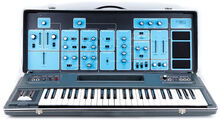
Moog Sonic Six. Note the built-in loudspeaker at right. Photo courtesy of Vintage Synth Explorer.
A monophonic synth produced by Moog Music from 1972 to 1979. (Despite what the name might suggest, the synth is not polyphonic, although it does have duophonic capability.) The Sonic Six is an outlier among Moog products both in its design and in its provenance, since its original design did not come from Moog Music at all. Both its circuit design, and its panel layout and packaging, are radically different from other Moog products of the era.
Per a Gordon Reid article published in Sound on Sound magazine in 2002, the design stemmed from an ex-Moog employee named Gene Zumcheck, who was hired by investor Bill Waytena in 1969 to design a synth for his company Musonics. Zumcheck's work resulted in a synth called the Sonic V, which Musonics unsuccessfully marketed. However, in 1970, when Moog was seeking an investor for his company, the person he wound up doing business with was Waytena, who merged Musonics with R.A. Moog to create Moog Music. So the Sonic V, Musonics' only model, wound up being a Moog property. Bob Moog decided to market the unit as an alternative to the Minimoog; he added a few features (notably a pitch wheel), repackaged the unit such that it was built into a road case a la the EMS Synthi-A, and offered it as the Sonic Six. It offered two VCOs, two LFOs that could be cross-blended (a feature found on no other Moog model until the Multimoog), a ring modulator, and a duophonic keyboard which allowed the two VCOs to track two different notes on the keyboard (and it was possible to make one oscillator use portamento and the other one not). There was also a ring modulator (another feature not typical of vintage Moogs), and a variety of unusual routing options and external I/O. Finally, the Sonic Six had a built-in amplifier and speaker. Later models also had a dedicated headphone output, and it was possible to switch in any combination of the internal amp, the headphone out, and the external amplifier out.
To work around Moog's filter patents, Zumcheck had originally designed a VCF based on a diode ladder circuit. This gave the Sonic Six's VCF a notably different sound than other Moog models. During the model's production run, this was changed to the Moog transistor ladder design. The Six also used a different VCO circuit design from the other Moogs; Zumcheck's design was based on the UA726, and as a result was more stable than other Moog products of the time. Late in the Minimoog's production run, around serial number #9000, it was changed to use the Sonic Six's VCO design.
No production estimates are available; the Sonic Six was certainly not as popular as the Minimoog, of which about 12,000 units were built. However, the model does have a special place in Moog history. Bob Moog spent many years lecturing at schools on electronic music, and it was often noted that during the 1970s, when he taught, the synth that he took with him as a demonstrator was usually a Sonic Six.